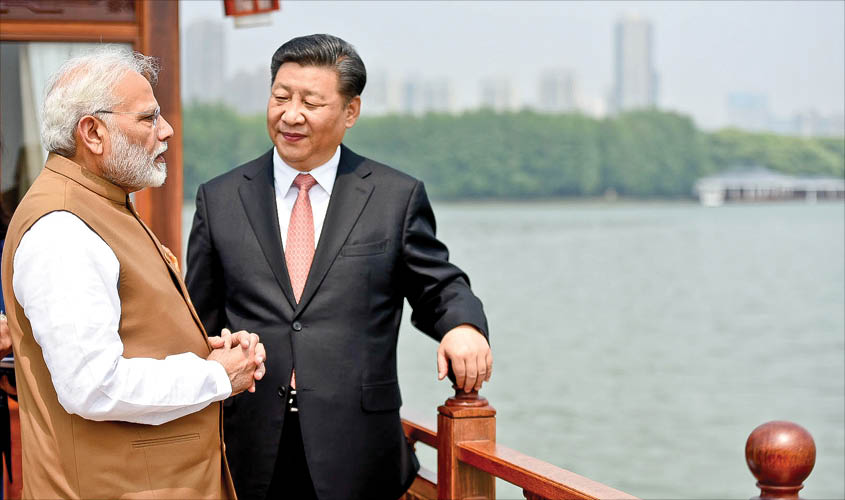China understands the vitality of engaging India. Divides will be bridged only when the boundary dispute is resolved.
On 23-24 November, India and China held talks on the boundary dispute for the 21st time over the past 15 years in Dujiangyan near Chengdu city in China. Represented by Wang Yi, the State Councillor and Foreign Minister of China, and National Security Adviser Ajit Doval, the meeting assumed significance as it was the first formal boundary talk after the Wuhan Informal Summit between Prime Minister Narendra Modi and Xi Jinping, the Chinese President.
While the 72-day-long Doklam stand-off along the India-Bhutan-China boundary was one of the dimmest phases in India-China ties in 2017, where the two countries were staring at a long-drawn unease, the Wuhan summit in April this year brought the relations between the two Asian giants back from the cliff. Concerted efforts have been made by New Delhi and Beijing to normalise ties since then. The thrust of this two-way effort has been the realisation that moving towards a conflict situation will put both countries on harm’s way. Carefully articulated, as it was, Modi’s Shangri-La speech signals the evolving common understanding in New Delhi on how essential the dialogue for greater mutual understanding is.
Such an understanding has been strengthened by exchange of high-level visits. From the Indian side, Sushma Swaraj and Nirmala Sitharaman visited China to attend their respective Shanghai Cooperation Organisation’s meet. From the Chinese side, there was no dearth of visits as well. Chinese State Councillor and Minister of Public Security Zhao Kezhi, and Chinese Defence Minister Wei Fenghe visited India this year. PM Modi visited China twice this year: First for the Wuhan Summit and then to participate in the Shanghai Cooperation Organisation summit. Defence Secretary Sanjay Mitra also visited Beijing recently to attend the 19th India-China Defence and Security Dialogue.
A systematic analysis of China’s boundary approach tells us that China makes its best attempts to resolve the boundary dispute when confronted with threats at the domestic and external fronts. For instance, in the 1960s, Tibetan uprising and problems with India and USSR motivated China to resolve disputes with Myanmar, Nepal, Pakistan and Afghanistan. Then later in the 1990s, upheavals in Xinjiang, and the Tiananmen Square incident were two of the major compelling factors for China to move ahead with the dispute resolution process, with post-Soviet states (Russia, Kazakhstan, Kyrgyzstan and Tajikistan) and Southeast Asian countries (Lao PDR and Vietnam). China is again confronted with a range of challenges, which are primarily manifested in: the urgent need to make the Belt and Road Initiative (BRI) a success, which is facing some backlash in the region; preventing India to be a part of the US-led military coalition; and the ongoing US-China trade war. While these reasons do not guarantee a solution to the protracted India-China boundary dispute, it does give India some leeway while dealing with China. Surrounded with strategic uncertainties, Beijing would have found it relieving that New Delhi is not keen to choose sides and is making efforts to keep its relations with China on a separate keel.
That said, it would be naïve to expect that thorny issues between India and China, viz., China-Pakistan Economic Corridor (CPEC), India’s strong opposition to Chinese activities in Pakistan-Occupied Kashmir, and China’s reluctance to support India in its efforts to curb state-sponsored terrorism, are not likely to get resolved soon. The boundary question too is not likely to be resolved anytime soon. India’s trade deficit with China and latter’s presence in the South Asian region is also likely to grow, with the politico-economic asymmetry tilting more in favour of China with the launch of BRI.
New Delhi is mindful of such challenges emanating from China. It is not compromising on its core national interests, but while at the same time not allowing those differences to overshadow other aspects of India-China relations. While India gives emphasis on cooperation with China, it has not stopped a dialogue with other like-minded countries on the issue of how to manage the unpredictable elements of China’s unprecedented economic and military rise. The third quadrilateral security dialogue including Australia, India, Japan and the United States at the senior officials’ level was just concluded on the side-lines of the 13th East Asia Summit. India is not hesitating in putting forth its free, open and inclusive Indo-Pacific vision. Also, by putting ASEAN at the core of its Indo-Pacific policy, India has clarified it believes in regional peace and stability. That there is enough space in the world for both India and China, and there are enough areas for cooperation to jointly work on, which was the essence of the December 2010 Joint Statement released during Wen Jiabao’s India visit, is what India seems to be practicing.
The Special Representatives’ talks are highly crucial in building momentum for dialogue to ease tension between India and China. The Indian leadership is aware of the implications of removal of limit from the Presidential term in China. President Xi will be in power for a longer time and therefore, it makes sense for India to extend an olive branch to China. Considering India’s rising profile and stable politico-economic situation, China also seems to understand the vitality of engaging India. Deep-rooted divides will be bridged only when the boundary dispute is resolved, which should be manifested in gradual but substantive outcomes of such meetings.
Sana Hashmi is a Delhi-based Sinologist and the author of China’s Approach towards Territorial Disputes: Lessons and Prospects.

